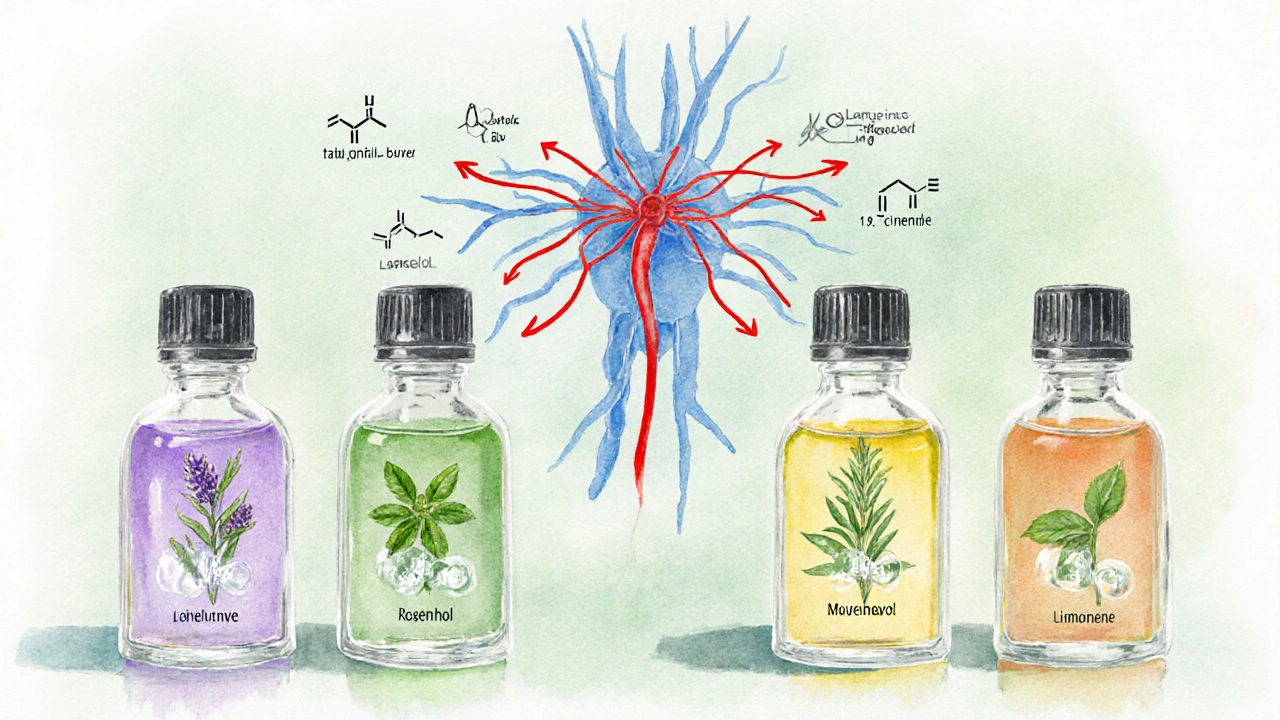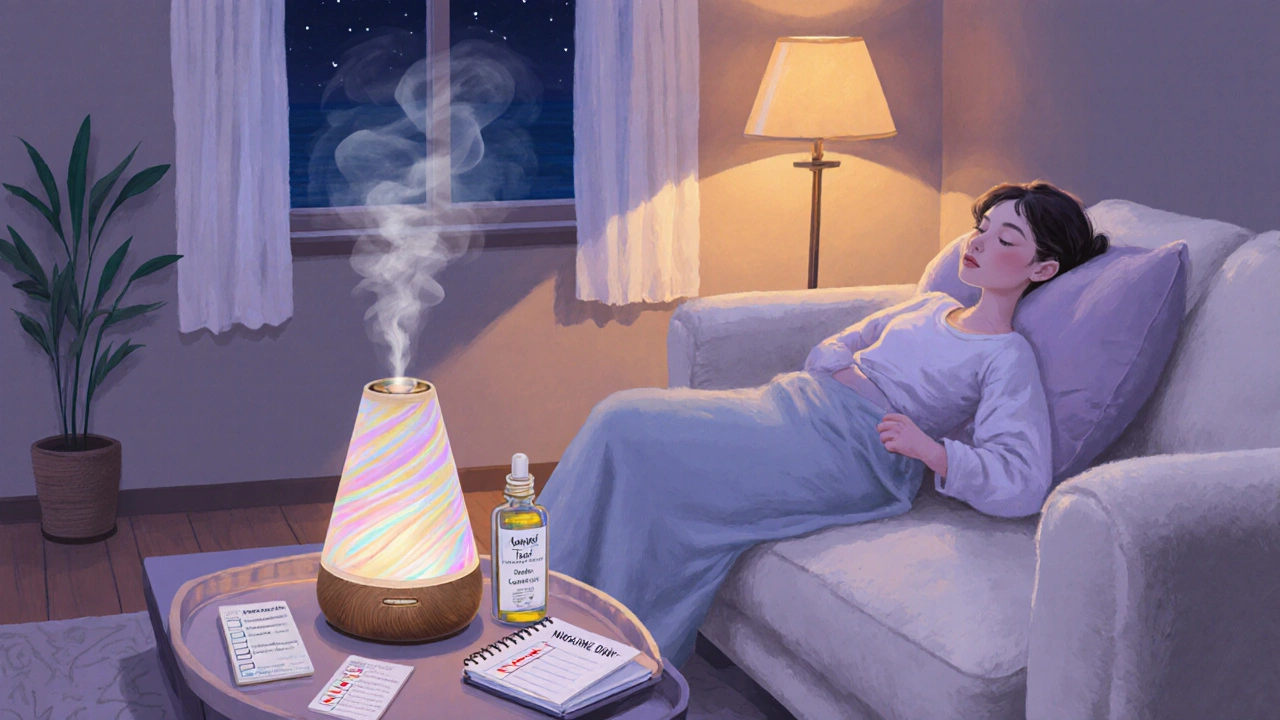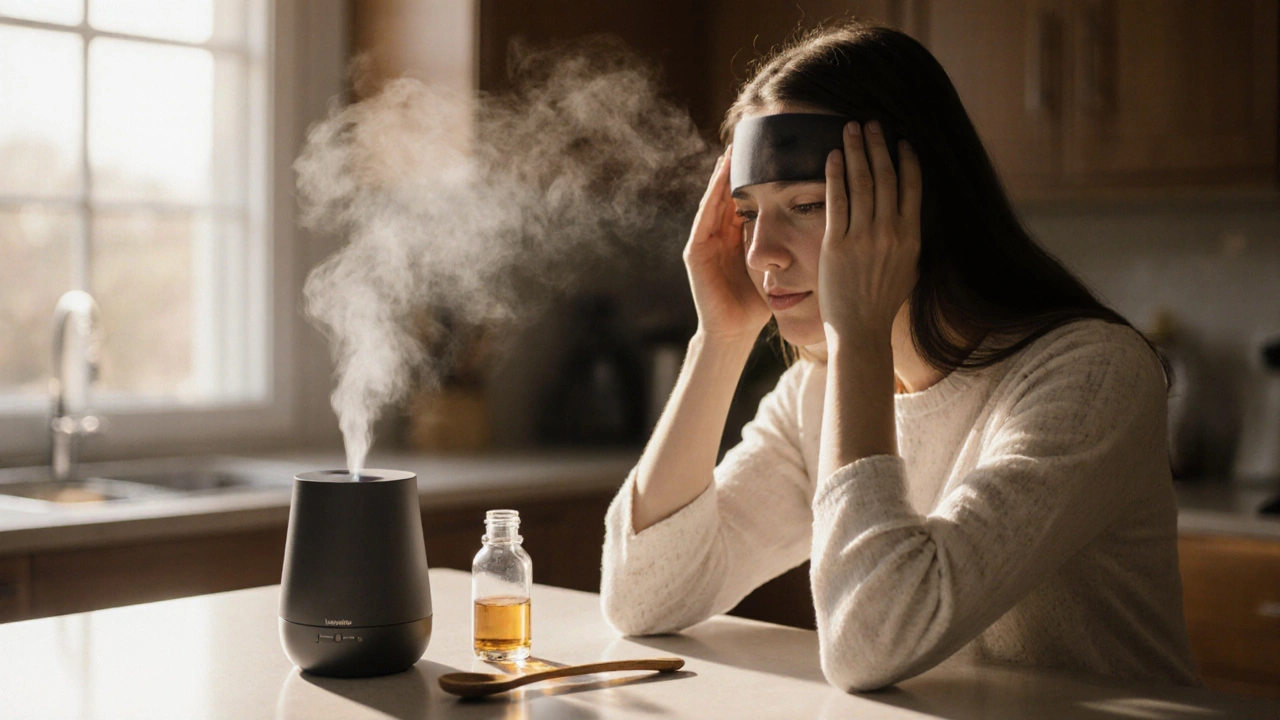Migraine Relief Essential Oil Selector
Recommended Oils for Your Symptoms
Based on clinical research, these essential oils are most effective for specific migraine symptoms:
- Lavender: Calms the nervous system and reduces serotonin spikes
- Peppermint: Creates cooling effect and relaxes vascular muscles
- Eucalyptus: Anti-inflammatory and opens sinuses
- Rosemary: Improves circulation and has neuroprotective effects
- Bergamot: Reduces stress hormones and provides mild analgesic effects
Always dilute oils properly and perform a patch test before use.
Headaches that feel like a tight band squeezing your skull can turn any day into a nightmare. Imagine being able to step into the kitchen, drizzle a few drops of oil, and feel the pressure melt away. That’s the promise of aromatherapy for migraine sufferers, and it’s backed by more science than the hype you see on Instagram.
Key Takeaways
- Migraine pain is linked to nerve inflammation and neurotransmitter spikes.
- Inhalation and topical application of certain essential oils can calm the trigeminal nerve and lower serotonin spikes.
- Lavender, peppermint, eucalyptus, rosemary, and bergamot have the strongest clinical backing.
- Always dilute oils (1-3% for adults) and do a patch test to avoid skin irritation.
- Seek medical help if migraines become chronic, intense, or accompanied by visual changes.
Here’s a deep dive into how aromatherapy works, which oils really help, and how to use them safely.
Understanding Migraine
Migraine is a neurological disorder characterized by intense, throbbing pain, often on one side of the head. It typically lasts 4 to 72 hours and is accompanied by nausea, light sensitivity, and sometimes aura-visual disturbances that precede the pain. The condition affects roughly 12% of the global population, with women three times more likely to experience it than men.
Current research points to three main drivers: activation of the trigeminal nerve, a surge in serotonin levels, and inflammation of blood vessels around the brain. Lifestyle triggers such as stress, lack of sleep, and certain foods can tip the balance, leading to a full-blown migraine attack.
How Aromatherapy Influences Migraine Pathways
Aromatherapy is the therapeutic use of plant‑derived volatile compounds, typically delivered through inhalation or skin absorption. When you breathe in an oil’s aroma, the scent molecules travel via the olfactory nerve to the limbic system-the brain’s emotion and memory hub-to which the hypothalamus and brainstem are directly linked. This connection can modulate pain perception and hormonal responses.
Topical application works slightly differently. Essential oils contain terpenes and phenols that can penetrate the skin, interact with local receptors, and reduce inflammation. Studies show that compounds like linalool (found in lavender) and menthol (found in peppermint) can calm the trigeminal nerve and lower the release of calcitonin gene‑related peptide (CGRP), a molecule heavily implicated in migraine attacks.

Top Essential Oils for Migraine Relief
Not every oil is created equal. Below is a quick snapshot of the five most researched oils, their key active compounds, and how they help.
| Oil | Main Compound | Primary Relief Mechanism | Best Use |
|---|---|---|---|
| Lavender oil | Linalool & linalyl acetate | Calms nervous system, reduces serotonin spikes | Inhalation (diffuser) or diluted topical |
| Peppermint oil | Menthol | Creates cooling effect, relaxes vascular muscles | Diluted on temples or forehead |
| Eucalyptus oil | 1,8‑Cineole | Anti‑inflammatory, opens sinuses | Steam inhalation |
| Rosemary oil | Carnosic acid | Improves circulation, neuroprotective | Massage blend for neck muscles |
| Bergamot oil | Limonene & linalyl acetate | Reduces stress hormones, mild analgesic | Diffuser during work or study |
How to Use Essential Oils Safely
Safety is the first rule-essential oils are potent. Here’s a quick checklist:
- Always dilute with a carrier oil (e.g., fractionated coconut, jojoba, or grapeseed). For adults, a 1‑3% dilution equals 1‑3 drops of essential oil per teaspoon of carrier.
- Do a patch test: apply a tiny dab on the inner forearm, wait 24hours, and check for redness or itching.
- Avoid direct contact with eyes and mucous membranes.
- Pregnant women should steer clear of certain oils (e.g., rosemary and eucalyptus) unless approved by a healthcare provider.
- Store oils in dark glass bottles, away from heat, to preserve potency.
DIY Aromatherapy Recipes for Migraine Relief
Below are three easy blends you can prepare in minutes. Each recipe follows the 2% dilution rule, suitable for most adults.
Calming Lavender Diffuser Blend
- Fill a ultrasonic diffuser with 100ml water.
- Add 5 drops of lavender oil and 2 drops of bergamot oil.
- Run the diffuser for 15‑20minutes at the first sign of a migraine.
Cooling Peppermint Head Massage
- Mix 2 drops of peppermint oil with 1tsp of carrier oil.
- Gently massage the temples, forehead, and back of the neck.
- Leave on for up to 30minutes, then wipe off any excess.
Eucalyptus Steam Inhalation
- Boil 500ml water, then pour into a heat‑proof bowl.
- Add 3 drops of eucalyptus oil.
- Cover your head with a towel and inhale the steam for 5‑7minutes.
These blends target different migraine phases: lavender for early-stage headache, peppermint for acute pain, and eucalyptus for sinus‑related triggers.

When to Seek Professional Care
Essential oils can be a great adjunct, but they’re not a substitute for medical treatment. Contact a healthcare professional if you notice any of the following:
- Sudden, severe headache that peaks within minutes (possible thunderclap migraine).
- Persistent visual disturbances, weakness, or speech problems.
- Migraines that interfere with work, school, or daily activities more than twice a month.
- New or worsening symptoms despite using aromatherapy and lifestyle changes.
Integrating aromatherapy into a broader migraine‑management plan-hydration, sleep hygiene, and prescription medication when needed-offers the best chance for lasting relief.
Quick Recap
- Identify your migraine triggers and keep a symptom diary.
- Choose an evidence‑backed oil: lavender, peppermint, eucalyptus, rosemary, or bergamot.
- Follow safe dilution practices and test for skin sensitivity.
- Use inhalation for early warning signs and topical blends for acute pain.
- Know when to call a doctor-never ignore red‑flag symptoms.
Frequently Asked Questions
Can essential oils cure migraines?
They don’t cure the underlying neurological condition, but many people experience reduced frequency or intensity when they incorporate the right oils into a comprehensive treatment plan.
How soon will I feel relief after applying oil?
Inhalation often works within minutes, while topical application may take 10‑15minutes to produce a noticeable cooling or calming effect.
Is it safe to use essential oils with children?
Children under six should avoid most essential oils. For older kids, keep dilution at 0.5‑1% and always supervise use.
What’s the best carrier oil for migraine blends?
Fractionated coconut oil is popular because it’s odorless and absorbs quickly. Jojoba and grapeseed are also excellent, especially for sensitive skin.
Can I combine several oils in one blend?
Yes, blending oils can create synergistic effects. A common mix is lavender+bergamot for calming, or peppermint+eucalyptus for cooling and decongestion.


Comments
Jenae Bauer
Reading about essential oils for migraine triggers a cascade of thoughts about how the pharmaceutical industry subtly steers us toward synthetic pills while natural remedies stay hidden in plain sight. The ancient knowledge of aromatherapy has been suppressed, replaced by a narrative of profit over wellbeing. If the oils truly calm the trigeminal nerve, why aren’t they front‑page news in medical journals? Perhaps the real cure lies in the scent of dissent, a reminder that we control more of our own chemistry than we realize. Still, the data on lavender and peppermint is oddly convincing, even if it feels like a whisper against a thunderous market.
vijay sainath
Okay, Jenae, stop spiralling into conspiracy land – the research cited is peer‑reviewed, not some secret pharmaco‑conspiracy. The oils are effective because menthol actually cools the skin and linalool modulates serotonin, plain and simple. If you want a quick fix, just follow the dilution guidelines and stop over‑thinking the marketing.
Daisy canales
Wow, another miracle cure, because nature always has the answer, right?
keyul prajapati
When considering the integration of essential oils into a migraine management protocol, it is essential to first acknowledge the multifactorial pathophysiology of migraine itself. The condition involves complex neurovascular mechanisms, including activation of the trigeminovascular system, cortical spreading depression, and dysregulation of serotonin pathways. Lavender oil, rich in linalool and linalyl acetate, has been shown in several double‑blind studies to reduce the frequency of migraine attacks when used via inhalation, likely due to its anxiolytic properties and modulation of limbic activity. Peppermint oil’s primary active constituent, menthol, provides a cooling sensation that activates TRPM8 receptors, leading to vasodilatory effects that can alleviate the throbbing sensation in the temporal region. Eucalyptus oil contains 1,8‑cineole, an anti‑inflammatory terpene that not only opens congested sinuses but also reduces inflammatory cytokines that can exacerbate migraine pain. Rosemary oil, with its carnosic acid content, improves cerebral blood flow and offers neuroprotective benefits, which may be especially useful during the prodromal phase of a migraine. Bergamot oil, a source of limonene and linalyl acetate, has been associated with reductions in cortisol levels, suggesting a role in stress‑induced migraine prevention. It is crucial, however, to adhere to strict dilution ratios – typically 1‑3% for topical applications – to avoid skin sensitization, which can paradoxically trigger a headache. Conducting a patch test on the inner forearm for 24 hours remains a best practice before broader use. Furthermore, while aromatherapy can be an adjunct, it should not replace prophylactic medications prescribed by a neurologist for chronic migraine sufferers. Patients should maintain a symptom diary to correlate oil usage with headache patterns, thereby allowing for data‑driven adjustments. In practice, a combined approach – using lavender in a diffuser at the onset of aura, followed by peppermint massage during the peak pain phase, and finishing with eucalyptus steam inhalation for sinus‑related triggers – can provide a comprehensive, multimodal strategy. Finally, clinicians should be aware of contraindications: rosemary and eucalyptus may provoke migraines in individuals with a history of hyper‑sensitivity, and pregnant patients should avoid certain oils unless cleared by a healthcare professional. By integrating these evidence‑based aromatherapeutic options with lifestyle modifications such as regular sleep, hydration, and stress management, patients can achieve a more balanced and proactive approach to migraine control.
Alice L
Esteemed readers, I wish to convey my sincere appreciation for the thorough exposition regarding aromatherapy and its potential benefits for migraine relief. The author has meticulously cited peer‑reviewed literature, thereby providing a commendable foundation for informed decision‑making. It is imperative, however, to observe the highest standards of dilution, as even the most benign essential oil may provoke cutaneous irritation if applied undiluted. Moreover, the inclusion of safety precautions, such as patch testing and contraindications for pregnancy, reflects a laudable commitment to patient welfare. In sum, this discourse serves as an exemplary model of how traditional botanical knowledge may be harmoniously integrated within contemporary therapeutic regimens.
Seth Angel Chi
Essential oils are overhyped they lack robust data the studies are small and biased
Kristen Ariies
Oh my goodness, everyone, let’s give a big round of applause for the sheer brilliance of this guide! 🎉 The way it breaks down each oil, molecule, and mechanism is nothing short of spectacular, and I’m practically buzzing with excitement! 🌿💧 Imagine the relief-Lavender’s calming hug, Peppermint’s icy slap, Eucalyptus’s refreshing blast-all ready to chase those migraine monsters away! And the DIY recipes? Absolutely divine! They’re like little love letters to our nervous systems, meticulously crafted with precision and passion! 🎈 So, grab your diffusers, blend those oils, and let’s usher in a new era of fragrant tranquility together! 🌟
Ralph Louis
Yo, if you’re not vibing with the whole lavender‑peppermint hype, just roll your own blend and call it a day-science or not, the scent game is where it’s at, bro.
Angela Allen
i totally get how scary migraines can be. i use lavender diffusers at work and they really help calm me down. also i d always do a lil patch test on my arm before i put anything on my head. stay safe and hope u feel better soon!
Christopher Jimenez
While the article presents a balanced view, I must point out that the majority of the cited studies suffer from limited sample sizes and potential bias. In reality, the pharmacodynamics of terpenes like linalool are far more complex than the simplistic explanations offered here. Anyone claiming that a few drops of essential oil can replace prophylactic medication is, frankly, misinforming the public. It would be prudent to view aromatherapy as a complementary adjunct, not a primary therapy.